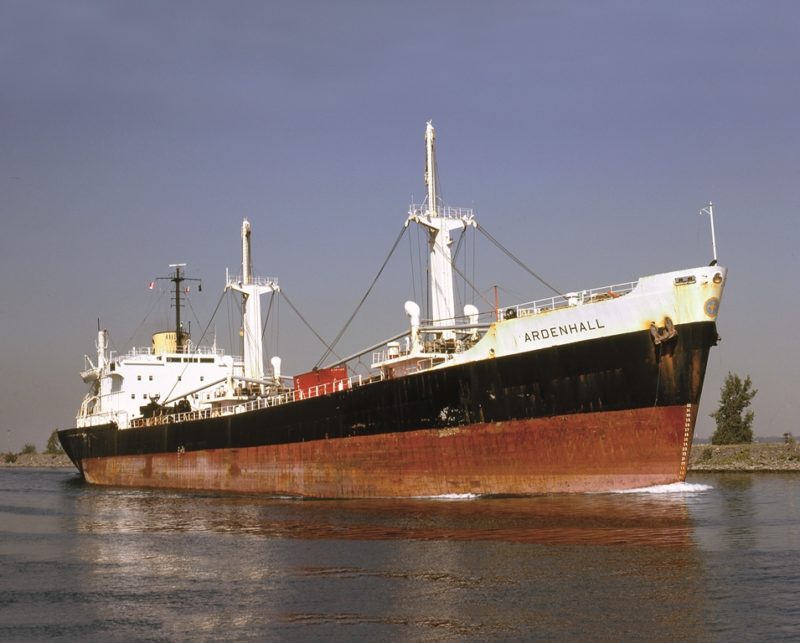
The company was founded in 1856 by Ralph Ward Jackson and Robinson Watson, both of Hartlepool, to operate five early, newfangled coastal steamers in the North Sea liner trades between West Hartlepool and Hamburg or St. Petersburg in summer when ice-free. Unfortunately the company’s bankers went into liquidation in 1866 and the fleet was sold to Christopher Webster of Pallion Hall, Sunderland with management in the hands of his son-in-law Capt. W.J. Young. In 1879 the tramping trades were entered with coal out to the Mediterranean and grain homewards from the Black Sea, with variations to Eastern seaboard U.S.A. and Canada. Capt. Young had previously served as a Master in the company ships and was made a partner for the twenty years he managed the company until his death in 1886.
Thomas Barraclough of Hartlepool was then appointed manager and he was maintaining the Hamburg service with three steamers in 1896, with another to Gothenburg and the Baltic and the remaining nine tramps operating world-wide.
In 1898 Sir Christopher Furness, the locally born shipping millionaire, gained control of the company and immediately set plans in motion to merge the company ships with the tramp fleet of another large Hartlepool shipowner, J.E. Guthe and set-up a limited liability company of the same name with a capital of £500,000 to expand the tramp fleet. This was done on the 2nd March 1899 with Christopher elected Chairman, J.E. Guthe as managing director, the other directors being Stephen W. Furness, Joseph F. Pease and Sir Edward T. Gourley, M.P. for Sunderland.
J.E. Guthe was a German immigrant who came from Leipzig to Hartlepool in 1875 and gained much of his early shipping experience with the local company Cory, Lohden & Co. His appointment meant that the previous managers Ernest Alfred Webster and Thomas Barraclough were free to set up their own tramp company as Webster & Barraclough of Hartlepool, trading successfully until the end of WW I. Sir Christopher Furness had now created a tramp company owning fifteen fine tramps with two more steamers, Gipsy Queen and Panther, maintaining the Gothenburg service, and three more operating to Hamburg, German Empire, Kaiser and Sprite. The first tramp with the suffix ‘Hall’ was the Haddonhall from the merged Guthe fleet. Orders were now placed for thirteen brand new large tramps mostly with yards under the control of Sir Christopher Furness:-
Irvine’s SB & DD (7) Clumberhall
Vauxhall,
Boltonhall,
Lindenhall,
Hendonhall,
Polamhall,
Grantleyhall
Furness, Withy (1) Daltonhall
R.Craggs (2) Askehall,
Birkhall
R. Stephenson (Tyne) (3) Dinsdalehall,
Cliftonhall,
Derwenthall
Triple expansion engines were provided by engine-builders in the Furness empire, Richardsons, Westgarth & Co. Ltd. of Middlesbrough and Hartlepool and W. Allan & Co. Ltd. of Sunderland. DaltonhallL was the first completed at the Middleton harbour yard of Furness, Withy & Co. Ltd. in Hartlepool in June 1899 but was purchased by Sir Christopher shortly after completion for his own fleet and traded for him under this name for the next 15 years.
In 1902 a joint service to the Persian Gulf from Manchester and Cardiff and London with Bucknall Line and Strick Line was started, quota agreement being reached in July 1903 as 23/60ths each to Strick and Bucknall and 14/60ths to West Hartlepool Steam Navigation Co. Ltd. In addition Frank C. Strick vigorously attacked the Army and railway trade into Bombay, which was open to tender, but both Bucknall and West Hartlepool Steam Navigation Co. Ltd. refrained to do so in case of retaliation into the Persian Gulf from the Bombay Conference companies of P&O, British India and Clan Line. The Persian Gulf quota agreement was for a period of six years until 1909, but by that time West Hartlepool Steam Navigation Co. Ltd. had ceased to trade there and concentrated on general tramping. The North Sea liner trades to Hamburg and Gothenburg ran on a reduced frequency until abandoned on the outbreak of war in August, 1914.
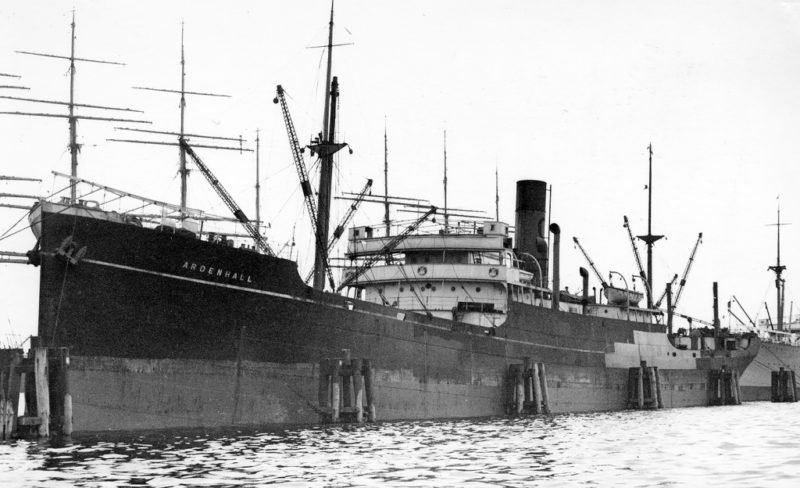
Sir Christopher Furness had sold his shareholding to J.E. Guthe in 1904 to concentrate on his own tramp fleet, the West Hartlepool Steam Navigation tramps having carried the ‘G’ of Guthe on their yellow funnels with a black top since the merger of 1899. He resigned from the Board together with Stephen W. Furness and Joseph F. Pease, leaving J.E. Guthe to be appointed as Chairman, with his son of the same name being appointed a director in 1906 and two further brothers joining the management company which was known as Guthe Brothers & Company at this time.
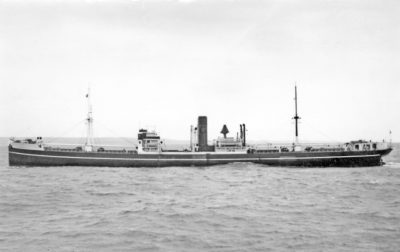
An interesting ship joined the fleet shortly before the outbreak of WWI and was renamed Wiltonhall. She had been built by J.L. Thompson & Sons Ltd at Sunderland in 1901 for the North Atlantic trades of T. Hogan & Sons of New York as Montauk but registered in Bristol. An exact sister, Matteawan, and three larger ships Mononmoy, Mohawk and Mineola were purchased in 1912 for Prince Line Ltd. managed by Sir James Knott. Three tramps were sold in 1915 to the London managers Brys & Gylsen Ltd. of Royal Lloyd Beige and were renamed Taxandrier, Brabandier and Cimbrier, with five further tramps being being sold at the same time to Houlder, Middleton & Co. Ltd., Maindy Shipping Co. Ltd. of Cardiff, T. Lewis of Cardiff, Letricheux & David Ltd. of Swansea and J. Esplen of Liverpool. They were replaced by two Glasgow tramps, Lissa from Glen & Co. renamed Apsleyhall, and Saint Helena from A. Mackay & Co. renamed Rytonhall, both becoming war losses:-
1.5.1916 Hendonhall – Mined/sunk in North Sea 2 miles SE of Inner Gabbard Buoy from mines laid by UC10 o.v. Portland (Me) to Rotterdam with grain
16.7.1916 Wiltonhall – Captured/sunk by bombs 65 miles NW of Algiers by U39 o.v. Bombay to Hull with general
1.8.1916 Heighington – Torpedoed/sunk 40 miles NE of Cape Serrat by U35 o.v. Naples to Oran in ballast
30.12.1916 Apsleyhall – Torpedoed/sunk 28 miles NW of Gozo, Malta o.v. Karachi to Cardiff with wheat by UC22. Master taken prisoner
7.5.1917 Polamhall – Torpedoed/sunk 80 miles WSW of Bishop Rock by U62 o.v. Alexandria to Hull with general
2.9.1917 Rytonhall – Torpedoed/sunk 105 miles off Ushant by UC69 o.v. from Montreal to Falmouth with wheat and flour
23.12.1917 Grantleyhall – Mined/sunk 5 miles E of Orfordness o.v. Villaricos to Middlesbrough with iron ore
20.8.1918 Boltonhall – Torpedoed/sunk in St. George’s Channel 34 miles WSW from Bardsey Island by UB92 o.v. Manchester to Gibraltar with coal, 5 lost

Two War ‘B’ types, War Crocus and War Tulip, were briefly managed for the Shipping Controller at the end of the war.
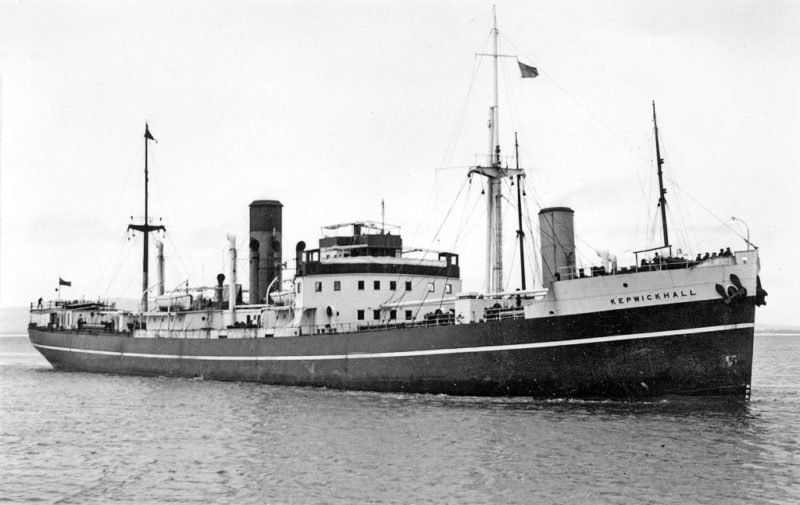
The career of War Crocus was particularly brief at less than a day sailing from her birthplace of Hartlepool in the evening of 7th July 1918 and being sunk 2.5 miles NE of Flamborough Head early the next morning. Her crew was saved and landed at Grimsby the same day. The war had also claimed one of the sons of J.E. Guthe on active service, with the founder himself passing away in 1916 and being succeeded by his son of the same name as Chairman of the company. There were four surviving tramps, Clumberhall of 1899, Lindenhall of 1900, Cliftonhall of 1907, Kepwickhall of 1916 with two further tramps being purchased at the end of the war. The first was Newfield, one of the last two surviving tramps of the Newcastle Steamship Co. Ltd., managed by the founding brothers J.J. & C.M. Forster, who had begun as tramp owners in October 1883 while operating from their home in Jesmond Dene in Newcastle. She was renamed Apsleyhall and kept for two years until 1920 when she became Cymric Queen and then in 1930 became the first Evans & Reid tramp as Nailsea Brook. The other tramp had been built in Hull for the Sea S.S. Co. Ltd. (W. Brown, Atkinson & Co. Ltd.) as Withernsea in 1912 and was renamed Ardenhall but again was only kept for two years before trading conditions were in a slump.
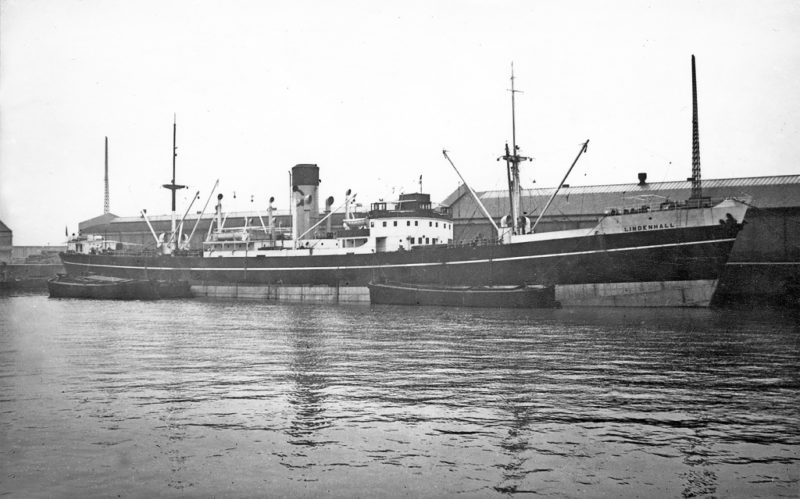
The depressed 1920s saw only second-hand tramps in the fleet:-
Siltonhall Ex Nurtureton of Chapmans
Woldingham Ex CameronN of K. McD. Cameron, Hartlepool
Kepwickhall Ex Ballygally Head of Head Line, Belfast
Ardenhall Ex Silverbirch of S. & J. Thompson
Apsleyhall Ex Silverash of S. & J. Thompson
Polamhall Ex Rhode Island of Warren Line, Liverpool
Hendonhall Ex War Bailey, Conoor (No)
Grantleyhall A War ‘N’ type which had lain on the stocks at the Greenock yard of Harland & Wolff Ltd. since 1919 for eight years before completion in August 1927
The following decade saw freight rates in a severe slump but the company showed great courage in ordering five new tramps from the local shipyard of William Gray & Co. Ltd., Clumberhall, Kepwickhall, Siltonhall, Boltonhall and Lindenhall.
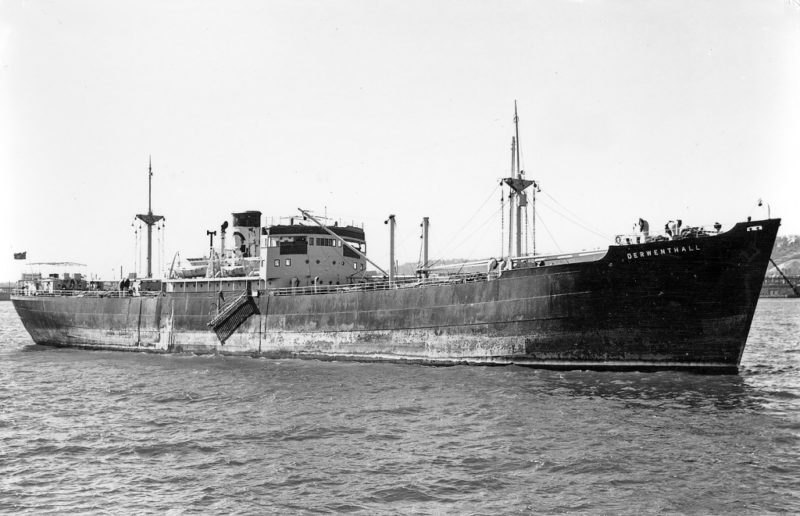
The first four completed were given quadruple expansion steam engines by the builder, whereas Lindenhall of 1937 was given a triple expansion engine boosted by a low pressure steam turbine. She had an unfortunate start to her career having to put into Dover with hot tunnel bearings where she collided with the breakwater and did such serious damage to her hull that she was forced to return to the dry-dock of her builders only five days after sailing. The first company motortramp was the ‘Doxford Economy’ Cliftonhall completed at Sunderland in May 1938. A further sister followed in April 1940 as Derwenthall and another as Daltonhall in June 1941, by which time the fleet stood at six tramps, of which two were lost to enemy action:-
12.6.1942 Cliftonhall – Torpedoed/sunk by Japanese submarine I-20 off Mozambique o.v. Alexandria and Aden to Table Bay and Chile, 2 lost
7.11.1942 Lindenhall – Torpedoed/sunk by U508 off Margarita Island, Venezuela o.v. Rio de Janeiro and Trinidad to New York and U.K. with ore, 42 lost.
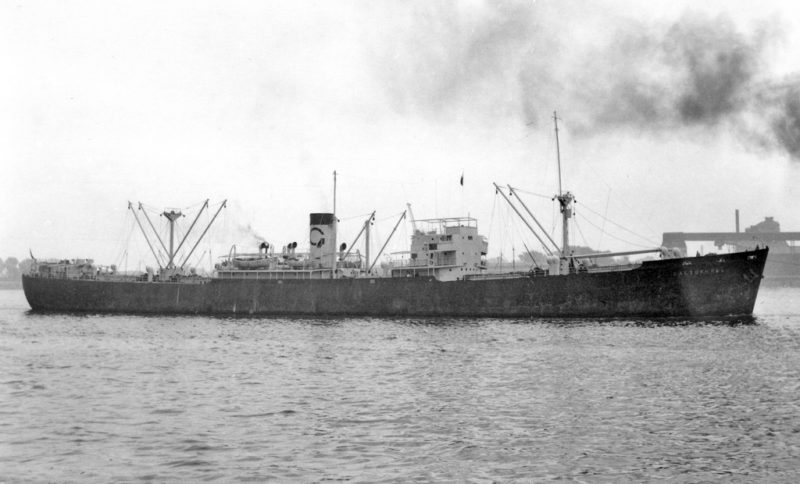
Lieutenant-General Yamada of the Japanese submarine I-20 sank three ships within 24 hours off the Mozambique coast, the Brocklebank cargo-liner Mahronda, Cliftonhall and the Yugoslav Supetar.
Lindenhall was badly damaged by parachute mines in the Royal Victoria Dock, London in March 1941 and was trapped in the dock along with other badly damaged ships and withdrawn from service for six months. After repair she was lost off Margarita Island, Venezuela with heavy loss of life when she quickly broke in two after the torpedo had struck. Two Doxford-built motortramps were managed for the Ministry of War Transport from completion in 1941/42 until transferred to the Dutch Government in 1943.
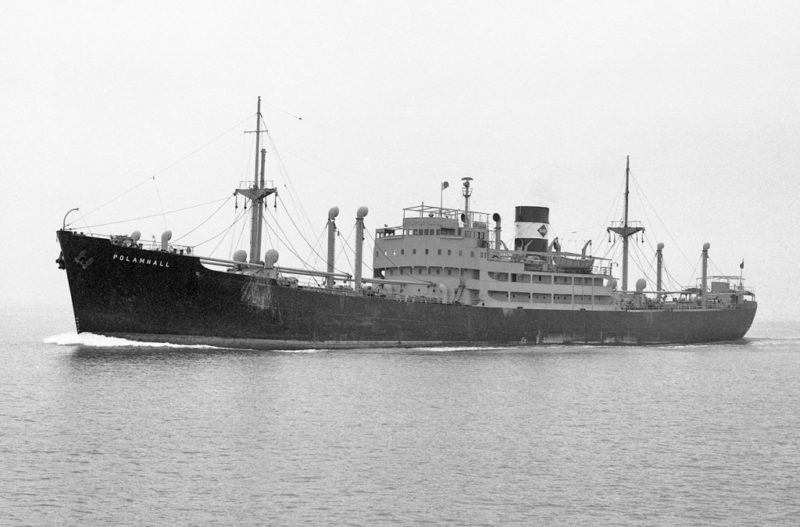
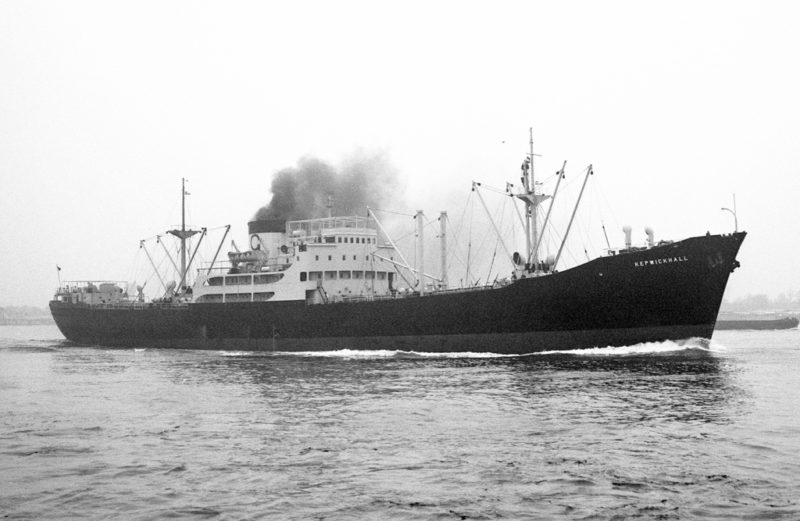
The surviving tramps were Clumberhall of 1930, Boltonhall of 1935, Derwenthall of 1940 and Daltonhall of 1941, the latter pair being ‘Doxford Economy’ motortramps. These two steamers were soon sold to London Greek owners, with Clumberhall becoming Ormos for Goulandris Brothers, and Boltonhall becoming Merchant Knight for Drake Shipping Co. Ltd. (Lykiardopulo & Co. Ltd.)
The first of a number of trawlers owned by the company in post-WWII years was completed at Beverley in 1947. A further Doxford Economy motortramp was purchased in 1947 as Empire General and renamed as Hendonhall.
The post-WWII rebuilding programme got underway at the Doxford yard in Sunderland at the beginning of 1950 with the launch of Polamhall of 9,220 dwt. A very similar sister was completed by the same builder as Kepwickhall in November 1956. Their 4-cylinder Doxford oil engines gave 4,800 bhp and a service speed in the region of 13.75 knots.
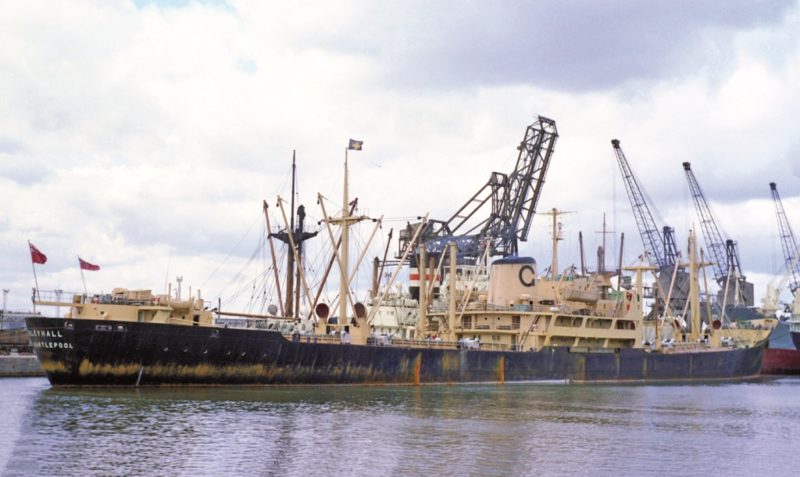
Full order books in U.K. yards meant that the company had to place their next order abroad, and was launched as Siltonhall at the Brodogradiliste yard in Rijeka, Yugoslavia during 1958 and completed in December of that year as Jalasilton for a five year charter to Scindia Line, to whom she was sold on termination of the charter. The larger Apsleyhall of 12,600 dwt was completed at the Doxford yard in 1963 and had five holds with bridge and superstructure amidships. The British-registered Crest Shipping Co. Ltd. with Yugoslav principals built their Skycrest of 14,875 dwt at this time at La Seyne with engines and bridge aft, and she joined the Hartlepool fleet next in 1968 as Grantleyhall.
Apsleyhall was sold in 1969 leaving Grantleyhall as the only owned tramp during the 1970s until the ‘SD14’ Lindenhall was delivered in July 1975 by Austin & Pickersgill Ltd. at their South Dock yard in Sunderland. A sister joined the fleet from fellow Hartlepool tramp owners Metcalfe Shipping Co. Ltd. in 1976 as Ardenhall. The Chairman J.E. Guthe sadly passed away in 1975 at the grand old age of 89 years and was succeeded by his son Digby Guthe.
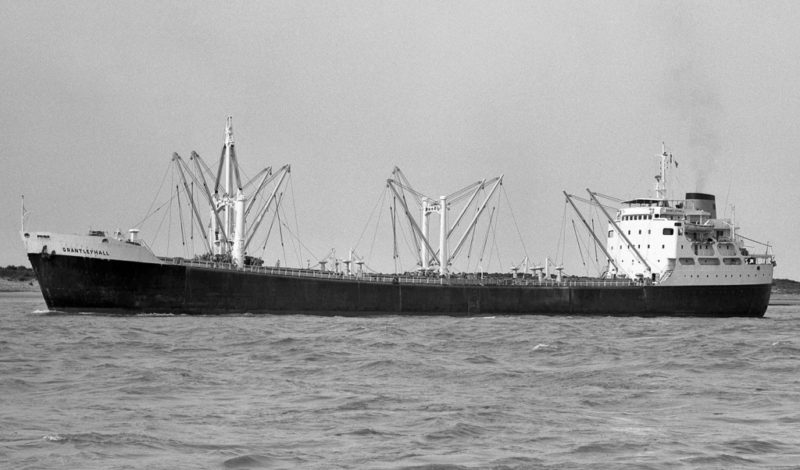
Lindenhall and Ardenhall were fitted with heavy lift derricks of 80-ton and 60-ton capacity respectively and made them very suitable for charter to liner companies for world-wide operation e.g. U.S. East Coast to Persian Gulf and U.K. to South Africa. However Ardenhall was sold in 1981 to Panamanian owners and renamed Moolchand, while further operating economies were made in 1982 by the transfer of Lindenhall to a Hong Kong associate company, Bush Hill Shipping Ltd., and renaming her Carlow Hill.
Sadly Digby Guthe, grandson of the founder, died on 23rd March 1982 at the age of 55 years while on a salmon fishing trip in the River Dee in Scotland. The company continued to make losses in the poor trading conditions of the 1980s, running up losses of over half a million pounds in 1984 and £288,210 in 1985. The continuing depressed state of the tramp shipping market forced the company to sell its last tramp, Carlow Hill, in March 1985 to Philippine owners. The famous houseflag of the cross of St. Hilda, Abbess of Whitby, was to fly no more. The company remains in business as shipbrokers and distributors of camping equipment.


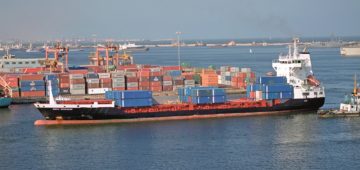



Comments
Sorry, comments are closed for this item